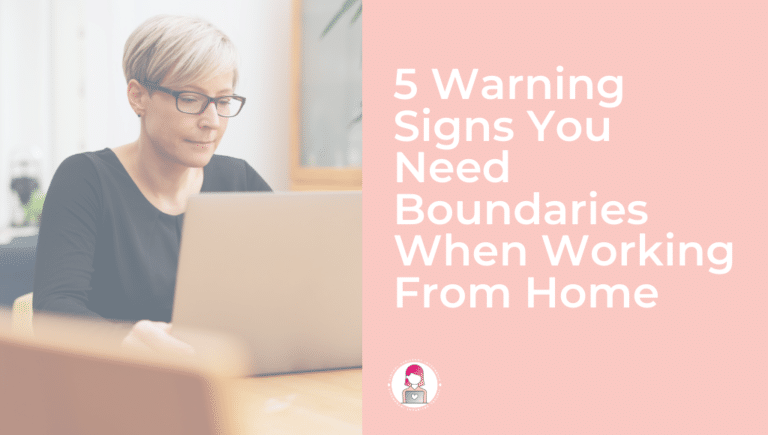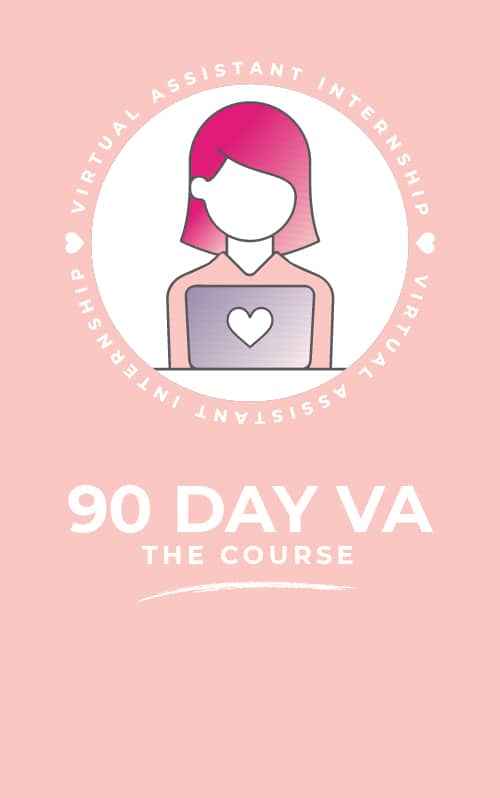Boundaries, boundaries, boundaries!
It’s time to dedicate an entire blog post to putting your foot down and letting your clients know how you work.
Unlike with your spouse or family, setting boundaries with your clients is a different animal.
It’s super important to set your boundaries before signing your first contract or accepting your first job working from home. Otherwise, you will set yourself up for failure.
Here are some common symptoms if you have no boundaries:
- You’re on call 24-7 (What’s a weekend again?)
- You forget to take time off for vacation, holidays, family, or you-time
- You feel tired, burnt out, and overbooked
- You’re missing important deadlines
- You feel like you can’t complain about the workload because you work from home, on the couch, in your PJs (Living the dream, right?)
If any of those symptoms are true for you – it’s time to re-evaluate your boundaries!
Let’s dive deep into 5 warning signs you need to look out for and how to set some that work for you when you’re working from home.

Sign #1 – You are Available Any Day, Anytime, Anywhere
If this is you, it’s time to set a new boundary. As a virtual assistant in a contractor position, self-employed, or with multiple clients, being available at every hour of the day is not sustainable.
Many of our students in 90 Day VA are so excited to get their first client that they forget to communicate their availability!
The clients are not your bosses. This means you need to let them know when it is okay to contact you.
If you take on a new client with the mindset that they’re your boss, there’s a higher chance that they will take advantage of you.
If the client thinks you’re available to them 24/7, eventually you’ll become frustrated, overwhelmed, and stressed.
“I can’t believe they’re contacting me at all hours – they are overworking me. This is too hard, too crazy, I quit.”
Take ownership and set specific times for when the client can contact you and when they can expect a response.
If you are super unhappy and your boundaries are not being respected, then it’s time to find a new client.
Next Steps to Reclaim Your Time
To prevent this situation, you need to plan and communicate your availability:
- As an independent contractor, you do not have set hours or days to work, and that is your right. If the client is paying you for 30 hours a week, they should not be calling you at midnight and surprising you with extra work. You are not their employee.
- You can also decide on what your response turnaround time is. Maybe it’s 24 or 48 hours, depending on the time zone difference between you and your client.
- Are you going to be available during holidays, projects, or product launches? How will you communicate if you or your client is on vacation? Set up contingencies if anything might be time-sensitive.
Your client has spent time collaborating with you and training you on their systems. They don’t want you to resent them, burn out, or leave – they want to keep working with you.

Sign #2 – Payment Insecurity
Money boundaries with your clients are just as important. Your clients need to know how you send your invoices, when they should pay them by and if you charge any fees for late payments.
The online payment world may seem scary if you’re starting to work from home, but it doesn’t have to be.
There are loads of platforms to send and receive payments domestically and internationally, including:
- Honeybook (use code “vai” for a discount)
- PayPal
- Wave
- Stripe
- Transferwise
You can research the options and choose the best one for you.
One major fear virtual assistants may have is not getting paid for the work you’ve completed. If the client doesn’t have a traditional brick-and-mortar location, how can you track them down?
Setting up payment boundaries ahead of time will save you the worry, and you can focus on your work.
Next Steps to Gaining Payment Security
These are some best practices I recommend:
Set up invoicing and get paid before you complete the work.
- For example, invoice your clients on the 15th of the month and give them 2 weeks to pay before releasing the completed work.
- You can set up a monthly retainer that the client pays at the beginning of each month to cover X amount of work clearly outlined in the contract.
You can also break up the invoice into 2 payments, where the client pays 50% before work starts and then 50% when it’s completed.
If your client absolutely insists on seeing the work before final payment, you can add a large watermark on top of each digital product and save the document as a PDF or another digital file format that they can’t edit easily.
- If you’re a web designer, you’ll usually never worry about not getting paid because you control the site and when it goes live.

Sign #3 – You’re Scared of Asking for More Money
You got your first paying gig as a virtual assistant at $20 an hour – yeah!
You’re grateful that during your first year of business:
- Clients paid on time
- They helped you develop your skills
- You had the flexibility of setting your own schedule
Now, you’ve upskilled, gained more experience, and added a new client for $40 an hour doing the same work.
Do you:
- Start thinking you could make much more money by letting go of your first client and signing new ones at $40 an hour?
OR!
- Start to feel resentful towards your first client because they haven’t offered you more money after the first year?
You need to be the one who communicates your wage rate changes. Don’t let your relationship with the first client sour because you’re upset they’re paying you less.
Your client won’t know you’re charging more unless you tell them. They are NOT your boss, so it’s not their job to give you a raise. That’s all you, girl!
Next Steps to Talking about Money with Your Client
Do you feel insecure about raising your rates? Having these tough conversations with your existing clients can help you set new boundaries and save you from being in a sticky situation.
- Try something like: “I’ve loved working with you this past year, but I’ve actually raised my rates.”
- You can build something in the contract for new clients where after 6 months or 1 year, you review the payment or package options again.
These conversations need to happen, but they can only happen when you take the initiative to set these boundaries.
A major part of 90 Day VA is the community of women (and men!) helping each other in the members-only Facebook Group. It’s fantastic to problem-solve issues like these and know you’re not alone.

Sign #4 – You’re Working Past Your Scope
It’s not only about getting the work and getting paid for it, but also how to thrive in a collaborative relationship once the work gets started.
Sometimes, the client needs extra help beyond the original scope of the contract.
You might find that you’re suddenly working 10 hours per week when you only agreed on 5 hours.
Or, the client asks you to work on some ‘little’ extra tasks, but the time quickly adds up.
If that’s the case, then you need to know how to manage scope creep. Setting up boundaries in advance is the best way to prevent this situation!
If your client keeps asking you to complete work past the scope, let them know you’d like to be paid for the additional hours.
Next Steps to Dealing with Extra Work Requests
- You can say something like, “I’m so excited to help you with that. It is outside the scope of our original agreement (attach if you want). I’m going to give you a new quote, a new hourly rate, or the project rate will need to be increased. Do you want me to assess the cost for that?”
- If they require an additional task to be done in less than 24 hours, or much earlier than you originally agreed upon. Try something like, “Okay, I can make that work, but it will be an additional amount of $X or a slightly higher rate per hour.”
Don’t feel shy about having these uncomfortable conversations. Have confidence that you can do it, and it’s never too late to start!

Sign #5 – Playing the Blame Game
If I could turn back time, I would have dropped some of my early clients sooner because they sucked the life out of me. They just weren’t a good fit.
Hindsight is 20/20, and I wish I trusted that there was another great client around the corner (because there always is).
When clear boundaries are not set up for communication or responsibilities, an ugly ‘blame game’ can start.
Maybe you blame yourself for every mistake or a missed deadline, or the client blames you or everyone else on their team for their mistakes.
Disorganization is fairly common with new business owners, and that’s okay. You can expect them to change their mind or not know what to do sometimes.
But how do you distinguish between a disorganized client versus a client that doesn’t take responsibility for their own mistakes?
Here’s how:
Next Steps to Avoiding Blame Games
Pay attention to any red flags or warning signs about potential clients’ communication styles.
If they are talking down to you, being rude, aggressive, or blaming you for problems beyond your work or responsibilities, be on high alert.
For example, maybe they hired you to manage their social media channels to drive more traffic to their website. Do they blame you because they are not selling as many products as they wanted?
- You are responsible for the social media engagement, but once the potential customer clicks through to the website – your job is done. (You aren’t responsible for how they respond to your client’s landing page or shopping cart experience)
- If you are getting blamed unfairly, you need to discuss it with your client in a calm and civil manner. Present the facts in a non-confrontational way. But if they aren’t willing to treat you with the respect you deserve, it may be time to part ways to make space for better clients!

Remember to explain to your client that you have a 24 hour response time to prevent any stressful last-minute requests.
When you collaborate with your client about project timelines and deadlines, build in extra days for revisions to go back and forth. These extra buffer days will allow for any client changes, family events, or any personal medical issues that may come up unexpectedly.
Setting clear expectations of goals and responsibilities ahead of time will prevent so many potential problems between you and your client.
These boundaries will save you headaches and self-doubt and pave the way for a better working relationship with your client.
Approach any issues that come up with a positive attitude and a willingness to work together.
My students have amazing success stories, choosing the kind of work and the hours they want to work. If you’re ready to live life on your own terms, check out my FREE masterclass to learn more.

In 90 Day VA, Esther teaches her students how to research and repurpose current content into blogs for the VAI website. Liz is the student we’ve chosen this week to feature what she’s learned in the course. Get to know her:

Liz Faulkner is a virtual assistant here to help businesses and entrepreneurs with their copywriting, blogs, content-repurposing, social media presence, graphic design and anything else that’s creative.
When she’s not on her laptop, she’s baking, swimming, traveling, and hanging out with her hubby and puppy.
She’s a member of the 90 Day VA. Connect with her on LinkedIn or Instagram to see how she can help you.



